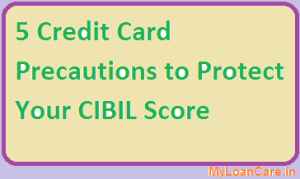Worried about the safety of your credit card? Heard about how a small mistake by your friend while using his credit card cost him dearly? Concerned about not being able to get a loan with a low CIBIL score in case your credit card is stolen and misused?
Relax. In today’s time and age, using a credit card is no more a luxury but actually a necessity. So, don’t worry and no need to stop using your card. You just need to take some basic care and take five basic precautions that will help you avoid a low CIBIL score:
1. Keep your password and PIN secure:-
The Reserve Bank of India has mandated that all online and offline credit card transactions in India must be authenticated by password and PIN or one time password (OTP). So, your credit card cannot be used in India for making a fraudulent credit card transaction online or offline unless someone hacks your password and PIN.
Read more:-
- PPF Interest Calculator
- FD Calculator to Calculate FD Maturity Amount with compounding
- Current Gold Loan Interest Rates
In India, we come across a very strange instance of people using credit cards at fuel pumps. Nothing wrong with it except that some people just don’t want to step out of the car and actually tell the PIN to the petrol pump attendant instead of feeding it into the machine. Now, if the pump attendant fraudulently clones the card, he can easily misuse it at any merchant location. Blame for this misuse clearly lies with the user and not with the bank.
2. Avoid transacting on international websites:
As regards the requirement for a PIN or OTP, there is a catch. This requirement is not valid for credit card transactions outside India or online on websites hosted outside India. So, it is possible that someone may use your credit card on one of these foreign merchant locations or websites hosted outside India if he/ she know your credit card number, expiry date and CVV. As a precaution, avoid making transactions on global websites that do not ask for the PIN or OTP.
One simple solution is to prefer RBI’s NEFT and RTGS modes for transferring money in India and SWIFT for international transfers. These can be accessed from your netbanking account and are fast and safe at the same time.
3. Keep your CVV number secure:-
CVV is a three digit number printed on the back side of the credit card next to the card number above the signature strip. Most websites require the user to enter the CVV number so as to ensure that the user actually has the credit card and is not just using a stolen credit card number. Banks recommend that the CV number be memorized by the user and then scratched off the card surface. The problem is that with multiple cards and so many other passwords to remember, this is easier said than done.
However, some merchant websites may not ask the user to enter the CVV number. So, take care that the site you are transacting on takes CVV verification in addition to the card number an expiry date.
4. Prefer chip based cards as opposed to magnetic strip based cards:
Now, what’s this? Let us explain. Actually, the front of the card which has your name, card number, expiry date and in some cases, a photo, has no machine readable authentication details. In earlier days, cards used to be recognized by the black colour magnetic strip that you see on the back side of the card. The problem with the magnetic strip is that it (or more precisely, the authentication data on the strip) can be duplicated and copies on to another similar magnetic strip using some simple readers.
Nowadays, banks also offer a more secure form of card which comes with a EMV chip as opposed to a magnetic strip. The chip contains the authentication data and the benefit is that the data on the chip cannot be copied unlike a magnetic strip. OK, we stand corrected. Impossible is nothing. So, data of chip is far more difficult to copy as opposed to that on a magnetic strip. So, prefer cards with chip as opposed to strips.
5. Place your signature on back of credit card:-
Why do banks have signature strip at back of the card? This is to ensure safety of transactions at physical merchant locations. The teller or the salesperson accepting payment by credit card is expected to get your signatures on the payment slip and match those against those on the back side of the card. Any mismatch between the two will lead to suspicion and the merchant may either deny the transaction or insist on further verification from the concerned bank. The bank may call up the actual customer on his registered contact number and manually authenticate the transaction. In case no signature is placed on the card, technically the card is invalid. However, as opposed to looking at this as a rule that you must follow, consider this as a safety feature for your own good.
